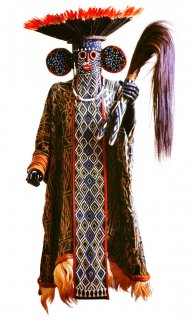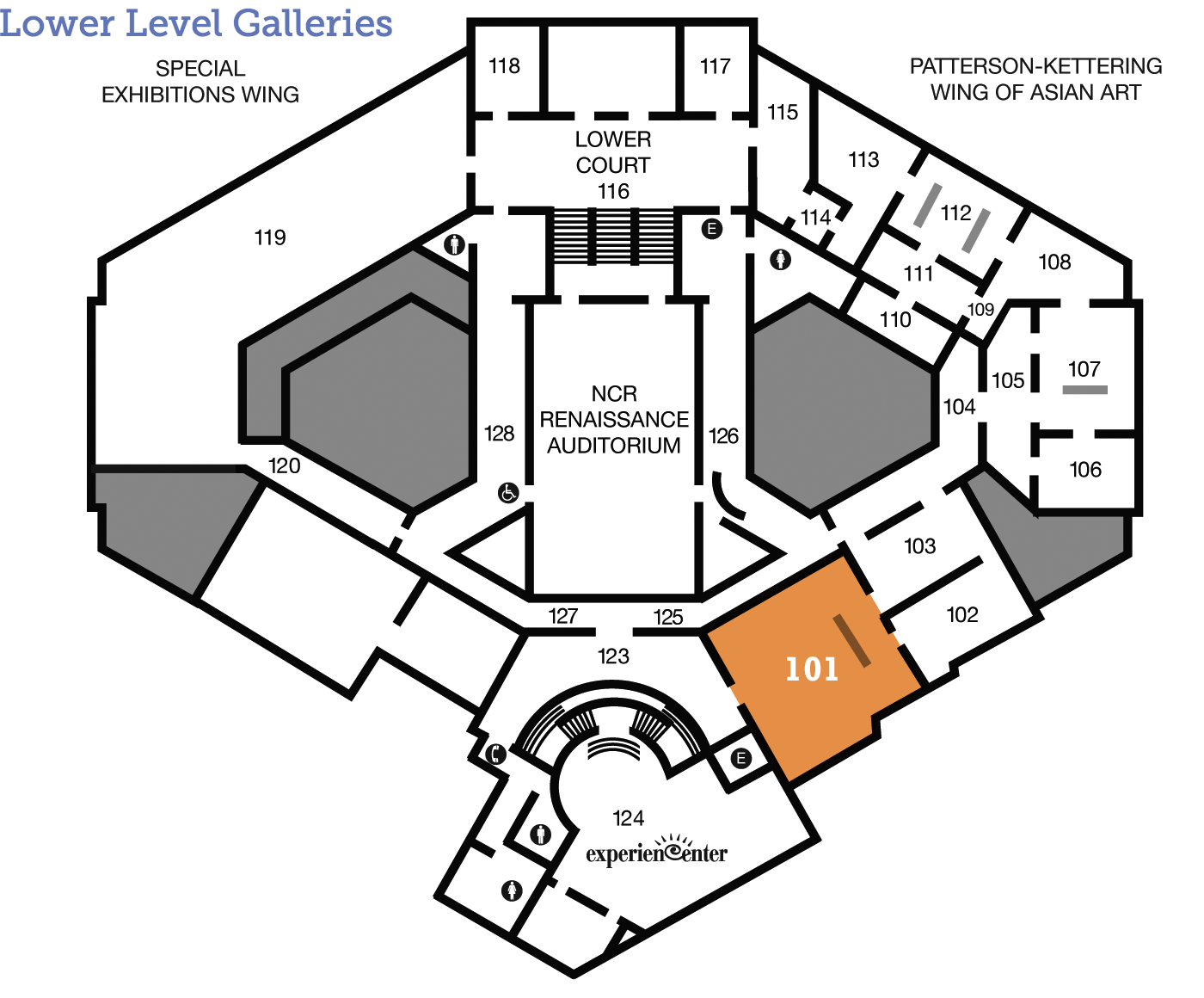
Bamileke people
Kuosi (Elephant Mask) Society Costume
Fabric, fur, hair, beads, ivory, feathers, twine Overall Height: 67 inches Museum purchase with funds provided by Dianne Komminsk 1999.76
Emblem of royal power
When do you wear a mask or a fancy costume? How does it change the way people see you? This costume would have been worn by a member of a Kuosi Society—an Elephant Mask Society. Take a closer look and find out how fashion can mix with politics.
A Day in the Life
Who are Those Masked Men?
This costume was worn by members of a Kuosi Society, or Elephant Mask Society. These secret societies supported the Fon (chiefs) of the Bamileke peoples in the grasslands region of Cameroon. They helped keep social and political order in villages and had secret weekly meetings. Elephant mask costumes like this one would be worn in public on special occasions, such as a general assembly held every two years, or for the funeral of a Fon or other important people.
Learn more about how this costume was used and why it represents an elephant and a leopard in the following video. Dr. Peri Klemm, Associate Professor of African, Oceanic, and Native American Art History at California State University, Northridge, and Dr. Steven Zucker, Emeritus Faculty at the Khan Academy, discuss a mask at the Brooklyn Museum of Art similar to this one.
Smarthistory, 2015, Creative Commons Attribution-NonCommercial-ShareAlike 3.0 License, https://creativecommons.org/licenses/by-nc/3.0/us/
Transcript:
Dr. Steven Zucker: We’re in the Brooklyn Museum looking at this magnificent beaded mask.
Dr. Peri Klemm: This mask is covered in beads. It was danced by the members of the Elephant Society, the Kuosi Society, in the Bamileke kingdom of Cameroon.
SZ: Cameroon is a country in central Africa, but we’re seeing this object hermetically sealed within Plexiglas in a museum, completely divorced from the way that it would have been used and understood in its original context.
PK: This was a masquerade, which involved not just a mask, but a costume, performers, musicians, and attendants, to bring this mask to life, to do what it was really supposed to do, in terms of honoring the king and bringing about social harmony.
SZ: So, we should not be seeing it frozen, hung as if it was just a piece of cloth.
PK: This object was obviously collected and now has a second life in this museum space. It’s very hard for us to recontextualize its original use, but we know from photographs that the Bamileke [Kuosi] Society would wear these with a red feather headdress, a leopard skin pelt, and a full-body costume. The leopard and the elephant were symbols of rule, and powerful symbols for the Fon. The Fon was a divine king who could transform into the elephant, and the leopard was thought to be an animal that could transform into a human. So, we have that connection between divine rule and the essence of these powerful animals.
SZ: The Bamileke that would have worn this would have been court officials, title holders, [and] warriors—people that held themselves great power—and in their association with the leopard and the elephant would have expressed the power of the king. And, in a sense, the political stability of that hierarchical order.
PK: The Bamileke king, the Fon, allowed this Society, and only this one, to dance the elephant mask and to wear leopard skin. They were entrusted with these symbols of authority and power. The main form in this beaded piece is the isosceles triangle, which relates to the patterning on the body of the leopard.
SZ: Highly stylized, though, as the entire mask is. It’s dazzling and it has a kind of optical quality that is full of energy and dynamism.
PK: And imagine when it’s worn and danced and performed; it would be incredibly dynamic with all of these various materials and colors and shapes all brought together to suggest the power of that king.
SZ: And in Cameroon today the Bamileke still perform this ritual, now annually, but instead of warriors performing it these are powerful members of the society.
Tools and Techniques
Creature Comfort
Besides looking like an animal, this costume contains real materials from four different animals.
Quiz
Look closer at the hat, the bracelets, the fly whisk, and the hem of the robe. What animals do you think these are made out of?
Grey parrot, elephant, horse, monkey.
Grey parrot, elephant, horse, lion.
Flamingo, elephant, cow, monkey.
Flamingo, rhinoceros, cow, monkey.
Behind the Scenes
Look Closer
All Decked Out
Like any great outfit this Kuosi Society costume combines many different pieces of clothing and accessories to create an eye-catching look. See some of these separately in the pictures below. Count how many different textures and colors you can find, and consider how they interact with each other to produce the overall effect.
Just for Kids
Look!
This mask is worn during special celebrations in Cameroon. When the costume is worn the person copies the movements of an elephant. Pretend you are wearing the mask. Carefully move around the room like an elephant.
What do you notice about the mask? Patterns can be found everywhere. Look around the museum, your classroom, your house, or even in nature. What patterns can you see? Can you describe them?
What patterns can you find on the elephant mask? Describe the pattern with a partner. Did you both find the same pattern or a different one? Together choose one you think is the most interesting. Sketch how this pattern might look if you were designing wallpaper or tiles.
Signs & Symbols
Dig Deeper
Arts Intersected
The Sculpture Speaks
Did You Know?
Expert Opinion
Look Around
Bedazzled
The hundreds of small beads covering the elephant mask and fly whisk are more than just decoration. Among the Bamileke people imported glass beads from places such as Venice or the Czech Republic were a significant trade item. So, wearing a mask with so many beads was also a way of showing off one’s wealth.
If you are in the African galleries, look around for other objects that use beads. These include apparel, such as the Royal Cap from the Yoruba people, but also adornment for figures, such as the Nkishi (Child Power Figure) from the Songye people. Consider how these compare with the kinds of things we use today to enhance our appearance and impress others.
 Songye people, Child Power Figures (Nkishi), 19th century, wood, horn, iron, brass, tacks, glass beads, raffia, cloth, fiver, tukula, symbolic substances, 8 ¼ x 2 ¾ x 3 ½ in. Gifts of Dianne Komminsk in memory of LaVerne Shone, 2007.114-2007.116
Songye people, Child Power Figures (Nkishi), 19th century, wood, horn, iron, brass, tacks, glass beads, raffia, cloth, fiver, tukula, symbolic substances, 8 ¼ x 2 ¾ x 3 ½ in. Gifts of Dianne Komminsk in memory of LaVerne Shone, 2007.114-2007.116
Further reading: Tamara Northern, The Sign of the Leopard: Beaded Art of Cameroon (Storrs: The William Benton Museum of Art, University of Connecticut, 1975).
About the Artist
Talk Back
Seeing through the Mask
This costume is an example of how the best products are often made for—and support the image of—those with power and material wealth. How may this affect your opinion of the costume’s overall quality?

